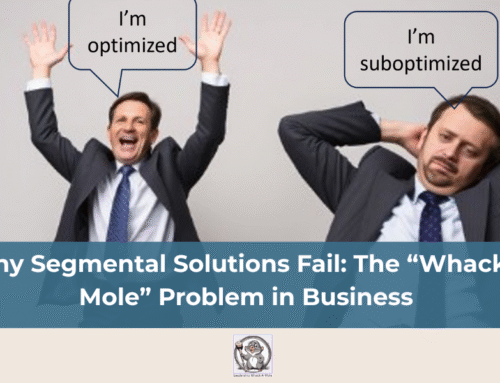
By Jeff Fierstein
With over 40 years of experience as both an internal and external management and Organization Development consultant and manager, I have witnessed firsthand the rise and fall of numerous “flavor-of-the-month” (F.O.T.M.) interventions. Early in my career, I quickly recognized that both public and private organizations are complex, dynamic systems, and managing or implementing change within them is a formidable challenge. Despite my extensive exploration into strategy, execution, systems, culture, productivity, processes, and quality, I learned that there are no quick fixes or one-time solutions to solving business problems or driving improvement.
The reality is that F.O.T.M. programs, which focus on isolated segments of an organization, fail to generate sustainable, large-scale change. Such programs are short-sighted because they overlook the interconnectedness of various organizational components. As outlined in Open Systems Theory, a change in one part of a system inevitably impacts other parts, often resulting in suboptimal outcomes across the organization.
For years, I worked with individual F.O.T.M. programs, aware of their inevitable decline over time. It was a frustrating experience, attempting to convince leaders and clients to embrace more comprehensive and sustainable solutions. As an external consultant, I often faced resistance from both leadership and internal stakeholders, who were aligned with quick-fix approaches. I encountered setbacks, including the end of projects, due to my stance against the immediate appeal of F.O.T.M. interventions. My objective was clear: to help organizations, whether for-profit, non-profit, or governmental, solve their problems, achieve excellence, foster growth, and cultivate respectful, people-centered cultures, all through a holistic, systems-based approach.
While teaching graduate-level Organization Development (OD) courses, I made it a point to emphasize that OD is not about isolated interventions but rather a holistic, systems-focused process. Unfortunately, over time, I witnessed the constant shift in OD practices, influenced by the latest F.O.T.M. trends. One year it was virtual training, the next year succession planning, followed by team building, Total Quality Management, personality profiling, 360-degree assessments, performance reviews, talent development, and so on.
A recurring challenge I encountered in my academic work was students’ limited understanding of “organization development.” When asked to define individual development in the workplace, students would typically reference skill acquisition, performance improvement, career progression, or succession planning—focuses on the individual rather than the organization as a whole. Similarly, while they understood the concept of team development, they struggled to grasp how one could “develop” an entire organization. Their exposure to management, primarily through F.O.T.M. programs, led them to believe that such programs were the standard approach to organizational growth—despite their lack of long-term success.
Over the years, I have continually emphasized the limitations of segmented interventions. Companies often seek quick fixes to large-scale challenges, but these solutions rarely address the underlying systemic issues. Our book, Leadership Whack-A-Mole: Actionable Strategies for Leadership Challenges reflects the lessons I’ve learned, the frustrations I’ve felt, and the barriers I’ve encountered while advocating for a more integrated systems approach to organizational development. We hope our book proves valuable for leaders looking to improve their businesses through thoughtful, sustainable strategies.
We are currently facing an urgent challenge in American business. With the rapid changes in global and domestic economies, geopolitics, pandemics, market disruptions, and technological advancements, organizations are struggling to keep pace. The “Digital Age” is here, yet many businesses remain entrenched in outdated Industrial Age practices and mindsets. Consider the persistence of legacy practices such as office-based work, annual performance appraisals, top-down decision-making, rigid organizational structures, and restrictive job descriptions—all of which limit employee growth and satisfaction.
We are still in the midst of a profound transformation, moving from the Industrial Age through the Information Age and now into the Digital Age. The explosion of knowledge, the rise of new technologies, and the shift from industrial to information-based work have posed significant challenges as we adapt to the evolving nature of work. This ongoing evolution underscores the inevitability of change, as aptly stated by the ancient philosopher Heraclitus: “Change is the only constant in life.”
As we continue navigating the transition into the Digital Age, we must cultivate agility and adaptability, with an ongoing commitment to change. Forward-thinking organizations will look to futurists to help guide the next phase of work and leadership. Our book aims not only to reflect on the current state of leadership but to encourage readers to embrace a proactive, future-focused mindset in leading their organizations. By applying the insights in this book, we hope to provide ideas that will help businesses transform both today and in the years to come.
Adapted from the book Leadership Whack-A-Mole: Actionable Strategies for Leadership Challenges (c) 2024 by Ric Shriver and Jeff Fierstein.
For more information on our book Leadership Whack-A-Mole: Actionable Strategies for Leadership Challenges and the authors, click here: www.leadershipwhackamole.com.
To see the book on Amazon, click on the banner:
We’d love to hear from you about this topic. Leave your comments below. Let us know if you’d like for us to email you for more discussion on Flavor-of-the-Month and OD issues.



